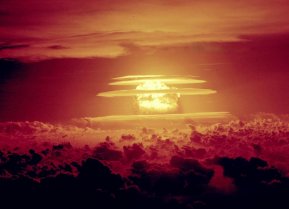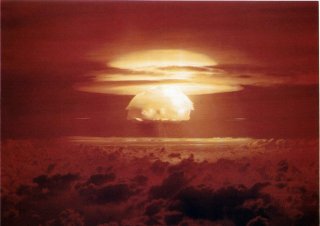Castle Bravo: Stare At the Biggest U.S. Nuclear Bomb Blast Ever
While significantly smaller in size and scale than the later Soviet's 1961 Tsar Bomba test, which yielded a 50 megaton blast, Castle Bravo was still 1,000 times as powerful as the "Little Boy" bomb that had been detonated over the Japanese city of Hiroshima less than a decade earlier. In what might have seemed almost ironic, the bomb used in the Castle Bravo test was dubbed the "Shrimp."
In the South Pacific, there was once a small patch of land that may have seemed at times to be as close to paradise on earth as one could get. It was likely similar to what people think of when they suggest they'd retire to a remote island in the middle of the ocean. At least Bikini Atoll was a paradise until it was chosen to be the location of some 23 nuclear tests conducted by the United States between 1946 and 1958.
Among the test sites is the infamous Castle Bravo, the first in a series of high-yield thermonuclear weapon design tests conducted as part of the larger Operation Castle.
A Mistake
The weapon used on March 1, 1954, remains the most powerful nuclear device detonated by the United States and had a yield equivalent of 15 megatons of TNT. That was actually unexpected in itself, and the explosion was 2.5 times more powerful than the predicted 6.0 megatons – a result of it being the first lithium deuteride fueled weapon.
While significantly smaller in size and scale than the later Soviet's 1961 Tsar Bomba test, which yielded a 50 megaton blast, Castle Bravo was still 1,000 times as powerful as the "Little Boy" bomb that had been detonated over the Japanese city of Hiroshima less than a decade earlier. In what might have seemed almost ironic, the bomb used in the Castle Bravo test was dubbed the "Shrimp."
In miscalculating the yield, the Shrimp had a devastating impact on the atoll and surrounding area.
The Fallout
The mushroom cloud from its detonation was massive and reached a height of 130,000 feet, whilst the explosion left a crater on the ocean floor with a diameter of 6,500 feet and a depth of 250 feet.
The radioactive fallout from the Bikini Atoll test was spread over a radius of more than 11,000 square kilometers and traces of material were detected as far away as Australia, India, Japan, the United States and even Europe.
Radioactive fallout heavily contaminated the Japanese fishing vessel "Lucky Dragon #5," which had the bad luck of sailing some 145 km downwind from ground zero. All of the 23 fishermen aboard the boat suffered radiation poisoning and one even died shortly afterward.
Unfavorable weather conditions during Castle Bravo also had the unfortunate consequence of sending potentially dangerous fallout over the inhabited atolls of Rongelap and Utrik in the Marshal Islands.
Jeton Anjain, minister of health and senator in the Marshallese parliament, later testified, "Approximately five hours after the detonation, it began to rain radioactive fallout at Rongelap. Within hours, the atoll was covered with a fine, white, powder-like substance. No one knew it was radioactive fallout. The children played in the 'snow.' They ate it."
The U.S. evacuated the inhabitants of Rongelap to Majuro two days after the test, the capital of the Marshall Islands. Many returned in 1957 but were evacuated again later that year out of concerns of the lingering radiation levels from the blast site.
The Marshal Islands became fully independent in 1986, and in addition to the United States being responsible for the security and defense of the islands, the two countries also reached a bilateral agreement that established the Marshall Island Nuclear Claims Tribunal, which was designed to award compensation for cancers and other serious health effects from the Operation Castle tests.
Peter Suciu is a Michigan-based writer who has contributed to more than four dozen magazines, newspapers and websites. He regularly writes about military small arms, and is the author of several books on military headgear including A Gallery of Military Headdress, which is available on Amazon.com.


